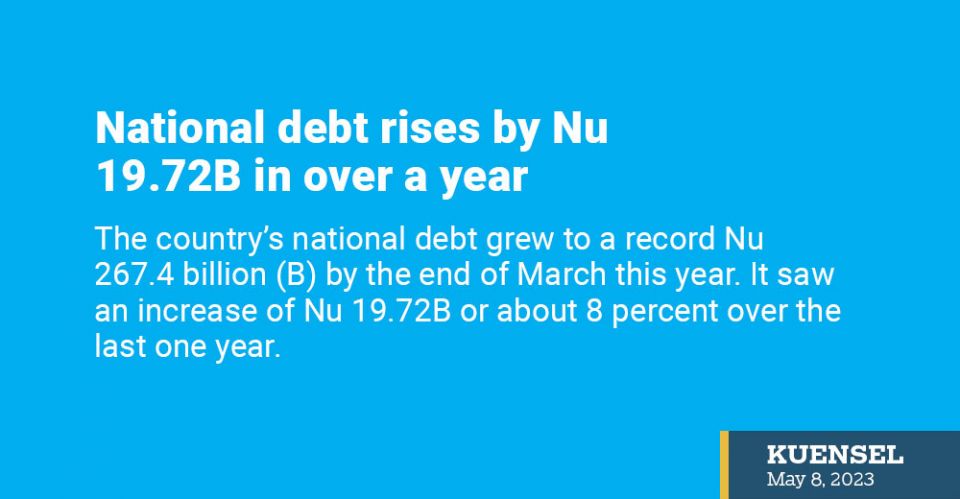
… country is in moderate debt distress
The country’s national debt grew to a record Nu 267.4 billion (B) by the end of March this year. It saw an increase of Nu 19.72B or about 8 percent over the last one year.
The debt, the total amount of money that the government owes, was equivalent to 132.1 percent of the gross domestic product (GDP) estimate for the fiscal year 2022-23.
Statistics from the finance ministry show that the growing debt was mainly because of a rise in external debt. The external debt is owed by the government, corporations, and the central bank.
External debt of Nu 222.11B as of March last year saw an increase to Nu 240.85B as of March this year, an increase of Nu 18.74B.
Domestic debt saw an increase of Nu 975.56 million (M) during the same period at Nu 26.55B. Domestic debt comprises Nu 11.85B treasury bills and Nu 14.7B government bonds.
Despite the high debt-to-GDP ratio, Bhutan’s 69.6 percent external debt in hydropower debt owed to India, the finance ministry points out is self-liquidating, given Bhutan’s power purchase agreements with India. Bhutan’s risk of debt distress is ‘moderate’.
The debt-to-GDP ratio gives insight into whether Bhutan has the ability to cover all of its debt.
According to the World Bank, the debt-to-GDP ratio is important because nations worry about default when the debt-to-GDP ratio is greater than 77 percent—the tipping point.
The Bank found that if the debt-to-GDP ratio exceeded 77 percent for an extended period, it slowed economic growth. “Every percentage point of debt above this level costs the country 0.017 percentage points in economic growth.”
The government debt that accounted for 91.8 percent of the total external debt was reported at Nu 221.18B as of March this year, an increase of Nu 15.28B from the same month last year.
Corporate debt accounting for 5.3 percent of the external debt was at Nu 12.67B. It also saw an increase of Nu 3.46B over one year.
However, the central bank still owed INR 7B for the standby credit facility availed from India in March this year.
On external debt classification by hydro and non-hydro, hydro debt accounted for Nu 167.74B, which is 69.6 percent of the total external debt. It comprises debt from six hydro projects—Mangdechhu, Puna-I, Puna-II, Nikachhu, Dagachhu, and Basochhu.
Non-hydro debt which accounts for Nu 73.11B equivalent to 30.7 percent of the total external debt.
Non-hydro debt to GDP ratio for the five-year plan period which is 31.5 percent as of March this year is within the threshold of 35 percent as required under the Public Debt Policy 2016, the finance ministry stated.
The increase in the external debt was mainly on account of disbursement received under the programme borrowings from the World Bank and Japan International Cooperation Agency, hydropower loans (Puna-I and II), and ongoing project loans. The other factor is the depreciation of Ngultrum against USD.
An increase in domestic debt was because of the government raising Nu 2.49B through the issuance of government bonds between April to June last year.
Over the year, the domestic debt saw a decline on account of payment on the government’s treasury bills outstanding, the rectification of the Bhutan Hydropower Services Limited loan availed from the National Pension and Provident Fund over the one year.
India remains Bhutan’s largest creditor with 65 percent of the external debt followed by 16 percent from Asian Development Bank and International Development Association.
INR-denominated debt accounts for 66.1 percent of total external debt, of which 95.6 percent was hydro-debt as of March this year.
At the same time, convertible currency debt stood at USD 988.69M, which is equivalent to Nu 81.69B. It accounted for 33.9 percent of total external debt.
On external debt servicing, the finance ministry projected that the external debt service to exports ratio could hit 16 percent in this fiscal year 2022-23 from 15.1 percent in the fiscal year 2021-22.
Bhutan’s Public Debt Policy sets the external debt service to exports ratio at 25 percent. This ratio measures how much the country’s export earnings will be servicing its external debt, exposing vulnerabilities to export shortfall, if any during the year.












